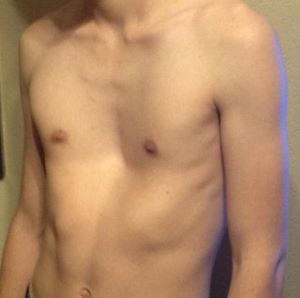
Ever hear of Pectus Excavatum? It’s the most common chest wall deformity and it occurs in about one in 450 children. Pectus excavatum or “sunken chest” is a depression in the chest due to the sternum and ribs developing abnormally causing the sternum to drop inward toward the spine. The depression may be in the center of the chest or more pronounced on one side (asymmetrical). You may also hear the terms “cup,” “saucer-shaped,” “horns of steer” used to describe this condition. A child can be born with pectus or develop their pectus during their pubertal growth spurt. The pectus may become more severe with growth spurts. Pectus excavatum is usually diagnosed within the first year of life and is four times more common in boys than girls.
Phoenix Children’s Hospital Chest Wall Program is the number one volume pediatric pectus center in the U.S. With 8 experienced pectus surgeons and a multidisciplinary team to care for patients, Phoenix Children's has less than a 2% complication rate, while the national average is 5%.
Why Have Surgery?
Surgical treatment of pectus excavatum is intended to reduce pressure on vital organs and create a more normal chest shape. It can also reduce or mitigate the following symptoms:
- Chest pains
- Shortness of breath
- Difficulty exercising
- Psychological symptoms, such anxiety or poor self-esteem
The Nuss Procedure
The Nuss Procedure is the most commonly performed operation for correcting pectus excavatum. Invented and introduced by Dr. Donald Nuss in 1998 after a decade of doing his own research, the Nuss procedure is considered “minimally-invasive” because only a few small incisions are needed. It employs metal bar(s) that act like braces for the chest, elevating the sternum to the desired position. Anybody who has ever worn braces for their teeth knows that each time the braces are adjusted, it hurts. Now, imagine your teeth were completely straightened in one day. It would hurt. A LOT. That is how the Nuss procedure works. The bar(s) elevate the sternum instantaneously. Pain is a BIG deal after the Nuss procedure and we are constantly looking for ways to improve pain control after the operation and we may have found a great way to reduce that pain at Phoenix Children’s.
Cryoanalgesia
In the 1970s, the first “cryoanalgesia” (cryo = cold, analgesia = inability to feel pain) systems were introduced. Rapidly freezing nerves to -50 to -70 oC causes controlled damage to the nerve, preventing the transmission of pain signals. It’s basically a way of cutting the nerve. Severing a nerve causes the nerve downstream of the cut to shrivel up and die. When a surgeon repairs a severed, s/he is sewing the insulation that surrounds the nerve (nerve sheath) back together. This allows the nerve to grow back along the nerve sheath and recover function. The nerve sheath is tougher than the nerve and is not damaged with freezing. Cryoanalgesia allows us to sever the nerve from within and preserve the sheath, thus providing pain control for a period of weeks to months as the nerve regenerates.
Cryoanalgesia has been around for a long time but only recently has it been used for pain control following the Nuss procedure. The Nuss procedure is performed in the normal way. At the time of the operation, we can see the nerves that provide sensation to the chest wall as the course along between the ribs. We insert the freezing probe and freeze 4-5 nerves on each side, resulting in numbness of a large portion of the chest. Cryoanalgesia adds about 30 minutes to the operation.
Pioneering Procedures at Phoenix Children’s
At Phoenix Children’s Chest Wall Center and Pectus Clinic, we have closely studied cryoanalgesia’s efficacy and safety. Prior to cryoanalgesia, patients were typically hospitalized for 5-7 days after the Nuss procedure for pain control usually with narcotic medications that are dangerous and highly addictive. Patients receiving cryoanalgesia during the Nuss procedure are usually hospitalized for 2 days. A huge benefit is that patients need about 80% less narcotic medications to feel comfortable. We find that feeling/sensation returns to normal in 2-3 months - by then, patients have recovered from the operation and are no longer experiencing pain.
We are proud to be among the first surgeons to adopt cryoanalgesia for the Nuss procedure and demonstrating that it’s safe and effective. Cryoanalgesia is a huge step forward for the safe and effective treatment of patients with pectus excavatum.
As always at Phoenix Children’s, multidisciplinary care is first and foremost for our patients. Our Chest Wall Clinic includes pectus surgeon and staff who work closely with our Pain Medicine Program, our Barrow Neurological Institute at Phoenix Children’s Psychology Program and our Physical Medicine and Rehabilitation Department. The biggest benefit to this team approach? Our patients can meet the entire team in one coordinated visit cutting down the number of commutes to the hospital.
Coordinated Care for Peace of Mind
Finding and receiving the pectus care your child needs shouldn’t be complicated. Whether you’re a local family or one of the many who travel to our center from out of town, we’re here to answer your questions and guide you to resources and support. We can even help address any insurance questions or issues you may be facing. Call us at (602) 933-0016.
